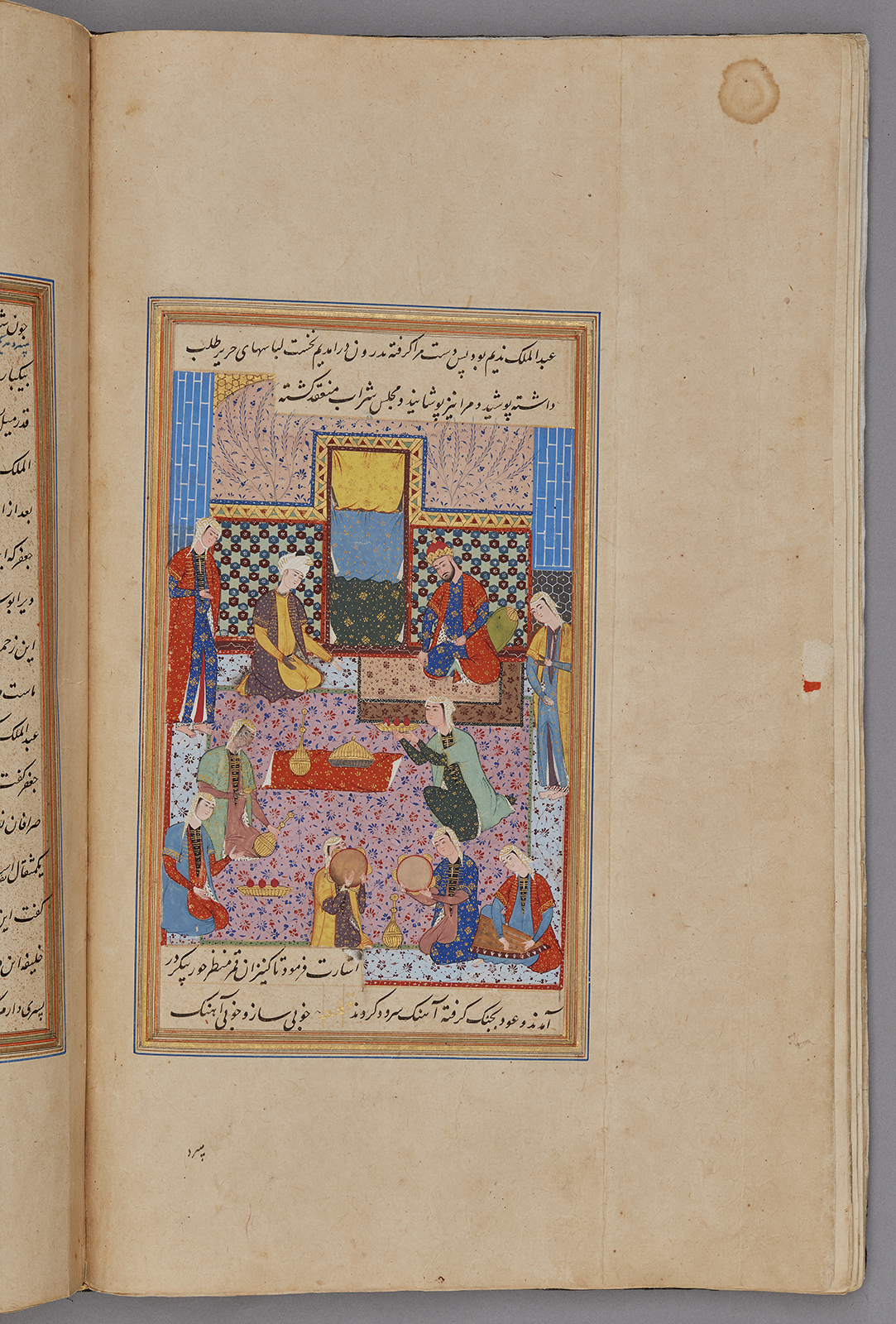Click on the image to zoom
In the Palace of the ‘Abbasid Caliph, Folio from a manuscript of Nigaristan
- Accession Number:AKM272.f37v
- Creator:Author: Ahmad b. Muhammad Ghaffari, Persian, died 1567 Scribe: Ahmad al-Shirazi
- Place:Iran, Shiraz (probably)
- Dimensions: 38.7 cm × 25 cm × 6.4 cm
- Date:1573-74 CE/980 AH/AH 980
- Materials and Technique:Ink, opaque watercolour, and gold on paper
The miniature painting "In the Palace of the ‘Abbasid Caliph" is from an intact manuscript of Kitab-i Nigaristan, a collection of anecdotes and historical incidents written in prose by the historian and scholar Ahmad Muhammad Ghaffari (1504–1567/68) of Kashan in 1551–2. This illustrated manuscript, dated 1573, was probably produced in a Shiraz workshop.
See AKM272 for more information about the manuscript and links to the other illustrations.
Further Reading
The miniature painting illustrates the moralizing tale of Jaʿfar Barmaki,[1] minister of the famous ʿAbbasid Caliph Harun al-Rašid[2] (786–809) in Baghdad. It displays the same compositional features as the interior court scenes[3] of Shiraz illustrations of the period. The image is placed in a rectangular frame between two textboxes above and below it. The crowned figure, the vizier Jaʿfar Barmaki, sits on a rug at the highest level of the room. On his right is his guest, who points and seems to converse with him. The figures in the lower part of the picture plane are women who hold percussion instruments and are presumably musicians or dancers.
The scene depicts a banquet with wine and music, during which the minister receives a guest who is a close relative of the caliph Harun al-Rašid. Despite his close relationship to the caliph, he is asking the minister for a favour. The anecdote points out the power and influence of the minister, Jaʿfar Barmaki.
This anecdote belongs to a genre known as nadira, which means "a strange event or happening." Within this genre, anecdotes about oddities and miracles refer to a historical or literary source and are narrated within a historical context. These strange events and miracles occur to rulers, scholars, viziers, and ordinary people in Iranian history from the introduction of Islam to the time of the Safavids (1501–1677). They offer an idealized version of history and often contain a warning or moral lesson. Ghaffari, as a historian, has produced the Nigaristan in such a way that the narratives are carefully sourced, but the content is mostly an idealized version of the history and is told for the benefit of the ruler. This approach to historiography was popular in Safavid Iran.
- Elika Palenzona-Djalili
Notes
1. Djaʿfar Barmakī (769–803) was the vizier of the ʿAbbasid Caliph, Harūn al-Rashīd.
See: https://www.iranicaonline.org/articles/barmakids.
2. Abbāsid Caliph Ḥārūn al-Rašīd was the most important ʿAbbasid Caliph who ruled in Baghdad. See: https://www.iranicaonline.org/articles/harun-al-rasid
3. Court Scenes that take place within a setting where a crowned figure sits enthroned are immensely popular in miniature paintings. The throne can be in a room or in a landscape, generally amid nature with flowers and trees in blossom. An interior court scene is mostly supplemented with other figures such as servants and musicians. For further reading about court scenes, see: Eleanor Sims, Peerless Images: Persian Painting and Its Sources.
References
Abbas, I. " Barmakids." Encyclopaedia Iranica, III/8, pp. 806-809
C. Edmund Bosworth, C. E. "Harūn al-Rashīd." Encyclopaedia Iranica, XII/1, pp. 17-20
Eleanor Sims, Peerless Images: Persian Painting and Its Sources. New Haven and London: Yale University Press, 2002. ISBN: 9780300090383
Note: This online resource is reviewed and updated on an ongoing basis. We are committed to improving this information and will revise and update knowledge about this object as it becomes available.


